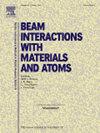Thermoluminescence properties of Y3Al5O12:Ce transparent ceramics at different linear energy transfers
IF 1.4
3区 物理与天体物理
Q3 INSTRUMENTS & INSTRUMENTATION
Nuclear Instruments & Methods in Physics Research Section B-beam Interactions With Materials and Atoms
Pub Date : 2025-07-03
DOI:10.1016/j.nimb.2025.165784
引用次数: 0
Abstract
Thermoluminescence (TL) properties of Y3Al5O12(YAG):Ce with different Ce concentrations after irradiations of gamma rays or heavy charged particles investigated analyzed. The TL glow curves were obtained after irradiations of gamma rays at different doses and the heavy charged particles at different linear energy transfers (LETs). The glow curves significantly depended on the gamma-ray dose or LET for YAG:Ce with low Ce concentration. This behavior indicates that the preferential trap centers are different for irradiations of gamma rays and heavy charged particles. The TL intensity decreased significantly with LET. The decrease can be explained with competition between the trapping of electron-hole pairs, which will result in TL upon heating, and the quenching of electron-hole pairs owing to excited states interaction. Notably, the decrease in the TL intensity with LET was suppressed at high Ce concentration. This is explained with faster trapping of electron-hole pairs becuase Ce3+ ions act as hole trapping centers, which results in a suppressed contribution of the quenching in the above-mentioned competition.
Y3Al5O12:Ce透明陶瓷在不同线性能量转移下的热释光特性
研究了不同Ce浓度的Y3Al5O12(YAG):Ce在伽玛射线和重带电粒子辐照后的热释光特性。得到了不同剂量的伽马射线和不同线性能量转移(let)的重带电粒子辐照后的TL发光曲线。对于低浓度的YAG:Ce,其发光曲线与γ射线剂量或LET关系显著。这一行为表明,伽玛射线和重带电粒子辐照的优先俘获中心是不同的。TL强度随LET显著降低。这种减少可以解释为电子-空穴对的捕获与电子-空穴对由于激发态相互作用而猝灭之间的竞争。值得注意的是,高Ce浓度抑制了LET对TL强度的降低。这可以用Ce3+离子作为空穴捕获中心,从而使电子-空穴对更快地被捕获来解释,从而抑制了上述竞争中淬火的贡献。
本文章由计算机程序翻译,如有差异,请以英文原文为准。
求助全文
约1分钟内获得全文
求助全文
来源期刊
CiteScore
2.80
自引率
7.70%
发文量
231
审稿时长
1.9 months
期刊介绍:
Section B of Nuclear Instruments and Methods in Physics Research covers all aspects of the interaction of energetic beams with atoms, molecules and aggregate forms of matter. This includes ion beam analysis and ion beam modification of materials as well as basic data of importance for these studies. Topics of general interest include: atomic collisions in solids, particle channelling, all aspects of collision cascades, the modification of materials by energetic beams, ion implantation, irradiation - induced changes in materials, the physics and chemistry of beam interactions and the analysis of materials by all forms of energetic radiation. Modification by ion, laser and electron beams for the study of electronic materials, metals, ceramics, insulators, polymers and other important and new materials systems are included. Related studies, such as the application of ion beam analysis to biological, archaeological and geological samples as well as applications to solve problems in planetary science are also welcome. Energetic beams of interest include atomic and molecular ions, neutrons, positrons and muons, plasmas directed at surfaces, electron and photon beams, including laser treated surfaces and studies of solids by photon radiation from rotating anodes, synchrotrons, etc. In addition, the interaction between various forms of radiation and radiation-induced deposition processes are relevant.

 求助内容:
求助内容: 应助结果提醒方式:
应助结果提醒方式:


